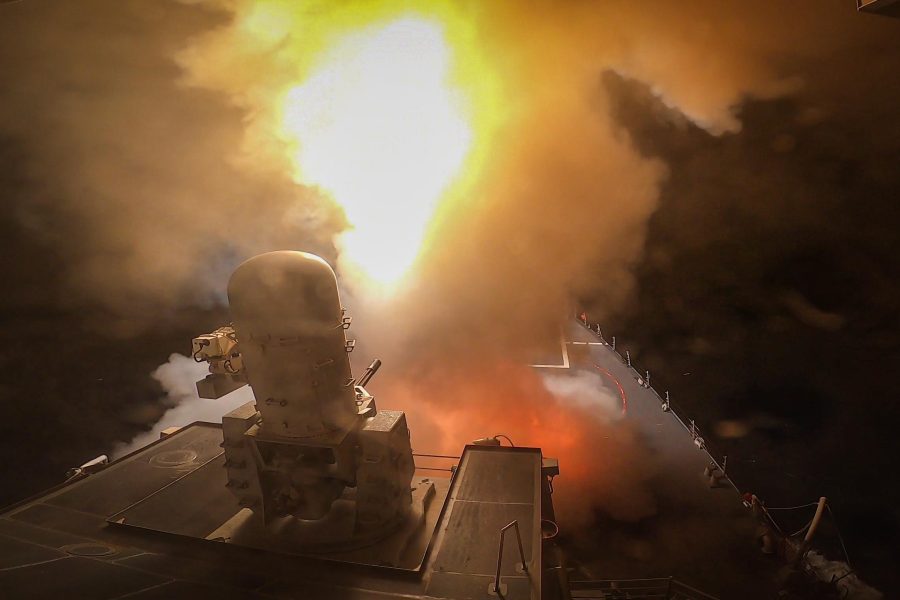Iranian-backed forces have once again stepped up their attacks against U.S. troops in Iraq and Syria and commercial vessels in the Red Sea in recent days, fueling concerns the Israel-Hamas war may lead to broader hostilities in the region.
As of Dec. 12, there have been at least 92 attacks on U.S. troops in Iraq and Syria by Iranian-aligned groups since Oct. 17, according to a U.S. defense official. Iranian-aligned Houthi forces also appear to be trying to draw the U.S. and its allies into a wider conflict by attacking vessels in the Red Sea.
Now, some former commanders of U.S. forces in the region are advocating for a more forceful response to deter further aggression and told Air & Space Forces Magazine that fears such action may escalate into a major U.S.-Iranian confrontation may be misplaced.
Secretary of Defense Lloyd J. Austin III will visit the region next week to ensure the “crisis doesn’t escalate into a broader regional conflict,” Pentagon Press Secretary Air Force Maj. Gen. Patrick S. Ryder told reporters Dec. 12. But Iran’s network of proxy groups—the so-called Axis of Resistance—appears determined to challenge those plans or at least act as a persistent thorn in the side of the U.S.
In particular, the Houthis have launched numerous cruise missile, ballistic missile, and drone attacks over the Red Sea in recent months; damaged ships; seized a vessel; and shot down an American MQ-9 drone.
“The actions that we’ve seen from these Houthi forces are destabilizing,” Ryder said. “They’re dangerous and clearly a flagrant violation of international law. This is an international problem that requires an international solution.”
The U.S. is working to put together a multinational naval task force to protect shipping in that important commercial waterway. But some observers say the U.S. should consider more forceful courses of action too.
“It’s not clear to me that responding to the Houthis’ provocations in Yemen, as a matter of self-defense, is necessarily escalating and would lead to significant Iranian involvement,” retired Marine Corps Gen. Kenneth F. McKenzie Jr., who commanded CENTCOM from 2019-2022, told Air & Space Forces Magazine. “It’s just not clear to me that there’s a linkage there.”
The Houthis’ targets initially appeared to be vessels with some connection to Israel. But they have since broadened to include numerous vessels, most recently on Dec. 11 when a land-based cruise missile struck the the Dutch-owned and India-crewed M/T Strinda. The commercial vessel was in the Bab el-Mandeb strait, a critical chokepoint for shipping, when it was targeted.
“The Bab el-Mandeb is incredibly important,” retired Army Gen. Joseph L. Votel, who commanded CENTCOM from 2016-2019, told Air & Space Forces Magazine.
The Houthis have promised to continue their attacks in the area.
“I think we have to take them at their word, and we have to make sure that is fully incorporated into our calculations and decision-making,” Votel added.
The USS Mason was dispatched to render assistance to the Strinda, U.S. Central Command said. The USS Mason and the USS Carney, both guided missile destroyers, have also been active in the region, downing Houthi aerial targets and escorting and rendering aid to beleaguered ships.
In response to the attacks in Iraq and Syria, the U.S. has taken retaliatory action and used an AC-130 gunship and an armed drone to preempt some militia attacks. The U.S. and its partners are in Iraq and Syria to fight against Islamic State militants and have continued that mission.
The USS Dwight D. Eisenhower, an aircraft carrier, was sent to the Middle East to deter Iran and other actors and its aircraft have been flying missions in support of the anti-ISIS campaign over Iraq and Syria, a senior U.S. defense official said. But the Houthis present a more vexing issue.
“We have no track record of anyone successfully deterring the Houthis, so we don’t know how they’ll react to force,” said Michael Knights of the Washington Institute for Near East Policy. “They want to be known as the biggest risk taker in the Axis of Resistance and the only one going toe-to-toe with the U.S.”
Unlike Iraq and Syria, the U.S. military has no forces in Yemen. Experts also differ over whether the Houthis are largely acting on their own with Iranian-supplied weapons or are being directed to attack by Tehran.
Some former commanders said, however, that there are legitimate military targets controlled by the Houthis in Yemen and the U.S. does not need to wait for the group to launch still more attacks on commercial shipping before taking military action.
“You could take action against coastal radars, coastal gun systems, missile systems, those kinds of sites,” said Votel. “There are very clear military targets.”
When Votel commanded CENTCOM, the U.S. struck radar sites in Yemen in 2016 in response to missile attacks, including toward the USS Mason, and the Pentagon cited the need to protect shipping in the Bab el-Mandeb as a reason for its actions.
Taking military action could have its challenges. Some of the systems may be mobile or could be resupplied. But Votel said it could also have a practical and symbolic impact.
“It can degrade their capability in the near term, and at the same time, send a very clear message,” he said.
